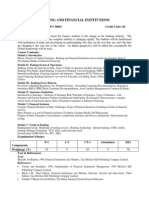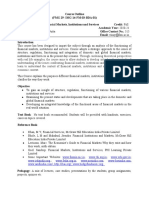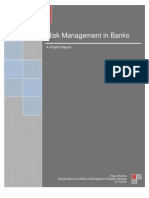Part (A) Indian Banking Credit:3: MOD NO. Detailed Syllabus Teaching Hours Objective of The Module Teaching Methodology
Part (A) Indian Banking Credit:3: MOD NO. Detailed Syllabus Teaching Hours Objective of The Module Teaching Methodology
Uploaded by
rajat_177229Copyright:
Available Formats
Part (A) Indian Banking Credit:3: MOD NO. Detailed Syllabus Teaching Hours Objective of The Module Teaching Methodology
Part (A) Indian Banking Credit:3: MOD NO. Detailed Syllabus Teaching Hours Objective of The Module Teaching Methodology
Uploaded by
rajat_177229Original Description:
Original Title
Copyright
Available Formats
Share this document
Did you find this document useful?
Is this content inappropriate?
Copyright:
Available Formats
Part (A) Indian Banking Credit:3: MOD NO. Detailed Syllabus Teaching Hours Objective of The Module Teaching Methodology
Part (A) Indian Banking Credit:3: MOD NO. Detailed Syllabus Teaching Hours Objective of The Module Teaching Methodology
Uploaded by
rajat_177229Copyright:
Available Formats
PART (A) INDIAN BANKING
MOD NO. DETAILED SYLLABUS TEACHING HOURS OBJECTIVE OF THE MODULE
CREDIT:3
TEACHING METHODOLOGY
Economic and monetary implications of modern banking operations. Banking structure in India.
Development Banks and specialized Financial Institutions like NABAKD, EXIM BANK, NHB, RRB Indian Scenario: Pre Liberalization and Post Liberalization. Globalization of Indian Banking Process of deregulation privatization Emerging Banking Trends Basel I, II, III, Bank balance sheet disclosures. Autonomy for commercial banks, Rating of banks. Risk Management, Asset Liability Management, Treasury Management, Universal Banking, Narrow banking, Retail Banking, Corporate Governance in banks. Deregulation of interest rates, prime lending rates, Base rate concept, LAF (Liquid Adjustment Facility, MSF (Market Stabilization Facility) Challenges and Issues facing the Banks: i) Asset classification ii) Capital adequacy iii) Risk weighted Assets. Narrowing of spreads and declining profits. Credit Policy: Basic principles of lending, classification of securities, features of good securities, Insurance of securities, pre-sanction appraisal, working capital Finance, Hypothecation, pledge, assignment, Mortgage, SARFESI ACT
13
Impact of Banking on Economic Development Role Played by Institutions in areas like Agriculture, Export, Import, Housing. Impact of Liberalization on Business Development To get an insight into the important concepts of banking functions
Theory
Theory
Theory
Theory
To understand the effect of RWAS on capital adequacy requirements of banks To enable students to understand the procedures relating to credit To enable students to understand various ratio which are important in assessing the credit proposal
Theory with Problems
Theory with Problems
Financial Statement Ratio Analysis. Case lets on balance sheet and Ratio Analysis.
Theory with Problems
Computers and Banking: Banking through Technology, Payment and settlement systems Act 2007. RTGS, NEFT, Cheque transaction system, Electromic clearing services core banking solution, SWIFT, SFMS, RBIs Internet banking guidelines, Cyber law IT act 2000
An insight into Banking technology. Students should be able to understand the importance of cultivating banking habit in every citizen
Theory
Latest Trends: Financial Inculsion, Business facilitators correspondents, Financial Literacy.
and
Theory
Total Text Books:
36 hrs
1. Management of Banking and Financial Services by Justine Paul 2. Banking Theory and Practice by K.C. Shekar and Lakshmisekar Viaks Publications
PART (B) FINANCIAL MARKET SERVICES
MOD NO. DETAILED SYLLABUS TEACHING HOURS OBJECTIVE OF THE MODULE
CREDIT:3
TEACHING METHODOLOGY
Introduction Capital Markets in India, Role of Capital Market, Initial Public Offering (IPO), Secondary Market and its Main Products, Equity Market, Debt Market, Index Linked Bonds, Golden Share, Sweat Equity. Foreign Direct Investment, Indian Depository Receipts. Global Depository Receipts and American Depository Receipts, Exchange Traded Currency Options, Participatory Note. Depository System, Dematerialization, Buyback of Shares by Companies. Applications Supported by blocked amount (ASBA) Stock Exchanges, Sensex, Book Building, Money Markets, Instruments, Certificate of Deposit, Commercial Paper, Call / Notice / Term Money, Bills Rediscounting, Treasury Bills. Total
3 12 hrs
To understand through the procedure which corporate revise capital from the market. To understand the various means through which capital can be ___ by corporates To understand the procedures in equity investments Impact of money markets on banks and on the economy
Theory
Theory
Theory
Theory
Text Books: 1. Indian Financial System by M.Y.Khan. Note: The syllabus has been framed for 48 hours comprising part A: Indian Banking and Part B: Financial Markets. Higher coverage has been given for India Banking keeping this aspect in view, the examiner should give a higher weightage of 3/4th for Indian Banking and the balance 1/4th for Financial Markets.
You might also like
- Handyman Business PlanDocument37 pagesHandyman Business Planmohammad100% (1)
- Vending Machines SolutionDocument6 pagesVending Machines SolutionizquierdofacturaNo ratings yet
- Differences of PFRS For SMEsDocument4 pagesDifferences of PFRS For SMEsJoy Angelique Javier100% (2)
- Banking - Theory and Practices 18MBAFM31-1Document88 pagesBanking - Theory and Practices 18MBAFM31-1Nandeep Hêãrtrøbbér50% (2)
- Banking Practice & Proc. Course OutlineDocument5 pagesBanking Practice & Proc. Course OutlineSuresh Vadde50% (2)
- Session Plan - Banking - Class of 2022Document6 pagesSession Plan - Banking - Class of 2022ZeusNo ratings yet
- BA7026 Banking Financial Services ManagementDocument120 pagesBA7026 Banking Financial Services ManagementchandrasekharNo ratings yet
- MBA3069 Commercial Banking CHODocument14 pagesMBA3069 Commercial Banking CHOMohit JamwalNo ratings yet
- Semester: III Finance Specialisation: Recommended BooksDocument12 pagesSemester: III Finance Specialisation: Recommended Booksshivaraj p yNo ratings yet
- MBA 3 Electives PDFDocument20 pagesMBA 3 Electives PDFSanika YadavNo ratings yet
- Bank Regulation and Resolution of Banking Crises: 15PFMC097 15 Year 1 Term 1Document4 pagesBank Regulation and Resolution of Banking Crises: 15PFMC097 15 Year 1 Term 1Tazeentaj MahatNo ratings yet
- Universal Banking LatestDocument189 pagesUniversal Banking LatestSony Bhagchandani50% (2)
- Fassh Bbe Sem 2Document11 pagesFassh Bbe Sem 2Areena KumariNo ratings yet
- Sem 2 SyllabusDocument49 pagesSem 2 SyllabushankschraderimpNo ratings yet
- Finance Sem III 2012-14Document10 pagesFinance Sem III 2012-14Arun GargNo ratings yet
- Financial Market and ServicesDocument12 pagesFinancial Market and Servicesbarshaadhikari83No ratings yet
- Central Banking SolutionDocument2 pagesCentral Banking SolutionrupalNo ratings yet
- Revised Syllabus of Continuous Professional Development ExaminationsDocument8 pagesRevised Syllabus of Continuous Professional Development ExaminationsSprasadNo ratings yet
- 4.36 M.com Banking & FinanceDocument18 pages4.36 M.com Banking & FinancegoodwynjNo ratings yet
- Overview of Banking: ObjectiveDocument3 pagesOverview of Banking: ObjectivePratik SawalaniNo ratings yet
- MBA-Financial AdministrationDocument38 pagesMBA-Financial Administrationanjalibhopale1169No ratings yet
- Syllabus Aug 2022 NHTM 2Document10 pagesSyllabus Aug 2022 NHTM 2Dương Thuỳ TrangNo ratings yet
- 07 Chapter 1Document72 pages07 Chapter 1Motiram paudelNo ratings yet
- MonetaryEc MonetaryEconomicsMajorDocument2 pagesMonetaryEc MonetaryEconomicsMajorahangerj96No ratings yet
- Lahore Garrison University: Course ObjectivesDocument2 pagesLahore Garrison University: Course ObjectivesMazhar Farid ChishtiNo ratings yet
- Consumer Perception Towards Public SectoDocument24 pagesConsumer Perception Towards Public SectojayNo ratings yet
- Syllabus Corporate BankingDocument2 pagesSyllabus Corporate BankingShashank Pal0% (1)
- PGDM II FINANCE ElectivesDocument21 pagesPGDM II FINANCE ElectivesSonia BhagwatNo ratings yet
- Syllabus Aug 2023-NHTM 2Document9 pagesSyllabus Aug 2023-NHTM 2Nguyễn Mai AnhNo ratings yet
- A. Preamble of The SyllabusDocument2 pagesA. Preamble of The SyllabussanjayNo ratings yet
- Baf 2203Document90 pagesBaf 2203geoffrey oodhiambNo ratings yet
- Ba8c3banking and Financial InstitutionsDocument1 pageBa8c3banking and Financial InstitutionsAyush ChhabraNo ratings yet
- DSE 5 Money and Financial MarketDocument2 pagesDSE 5 Money and Financial Marketsikusu61No ratings yet
- Thesis On Banking SectorDocument7 pagesThesis On Banking Sectorvaj0demok1w2100% (2)
- 82 Notification FASSHDocument83 pages82 Notification FASSHu5722d7gdgtlyf24z2kNo ratings yet
- Ankitha - Ret BankDocument25 pagesAnkitha - Ret BankMOHAMMED KHAYYUMNo ratings yet
- Syllabus 2020-22 FINTECHDocument58 pagesSyllabus 2020-22 FINTECHsukeshNo ratings yet
- Third Semester Financial Management Specialization: 20 MBA FM 321 Working Capital ManagementDocument58 pagesThird Semester Financial Management Specialization: 20 MBA FM 321 Working Capital ManagementsukeshNo ratings yet
- CAIIBITDocument27 pagesCAIIBITMLastTryNo ratings yet
- A Study On Financial Aspects of Share Price Behaviour in Commercial BanksDocument6 pagesA Study On Financial Aspects of Share Price Behaviour in Commercial Banksbubbly_vedhaNo ratings yet
- SyllabusDocument8 pagesSyllabusyamumini07100% (1)
- Banking: Treasury ManagementDocument117 pagesBanking: Treasury ManagementRoelienNo ratings yet
- Banking System 1Document52 pagesBanking System 1Banshul KumarNo ratings yet
- Financial ServicesDocument2 pagesFinancial ServicesRasika KambliNo ratings yet
- LLB Banking Syllabus 2023Document7 pagesLLB Banking Syllabus 2023Shivam ChoudharyNo ratings yet
- Session Plan 1Document5 pagesSession Plan 1Sulabh GoelNo ratings yet
- Banking Theory and PracticeDocument1 pageBanking Theory and Practiceshivarajungeetha4048No ratings yet
- (Credit Hours 3) Corporate Financing Decisions: Text BooksDocument1 page(Credit Hours 3) Corporate Financing Decisions: Text Booksshraddha amatyaNo ratings yet
- Practice Banking SyllabusDocument2 pagesPractice Banking SyllabusSrinivas GowdaNo ratings yet
- FS FSMDocument3 pagesFS FSMAniketh KNo ratings yet
- EVOLUTIONOFBANKINGSYSTEM11Document6 pagesEVOLUTIONOFBANKINGSYSTEM11AayuNo ratings yet
- Principles and Practices of BankingDocument2 pagesPrinciples and Practices of BankingPuja DuaNo ratings yet
- DoMS Investment Banking Capital Market OperationsDocument2 pagesDoMS Investment Banking Capital Market OperationsKumarNo ratings yet
- Financial Markets, Institutions and Services (SAPR)Document4 pagesFinancial Markets, Institutions and Services (SAPR)VampireNo ratings yet
- Risk Management in BanksDocument47 pagesRisk Management in BankshitkarkhannaNo ratings yet
- Banking Law CCDocument3 pagesBanking Law CCNithya PrakashNo ratings yet
- Credit AnalysisDocument15 pagesCredit Analysisetebark h/michale100% (1)
- T R A N S F O R M A T I O N: THREE DECADES OF INDIA’S FINANCIAL AND BANKING SECTOR REFORMS (1991–2021)From EverandT R A N S F O R M A T I O N: THREE DECADES OF INDIA’S FINANCIAL AND BANKING SECTOR REFORMS (1991–2021)No ratings yet
- Islamic Finance: The New Regulatory ChallengeFrom EverandIslamic Finance: The New Regulatory ChallengeRating: 1 out of 5 stars1/5 (1)
- Bank Asset and Liability Management: Strategy, Trading, AnalysisFrom EverandBank Asset and Liability Management: Strategy, Trading, AnalysisNo ratings yet
- Chapter 08 - The Efficient Market HypothesisDocument7 pagesChapter 08 - The Efficient Market HypothesisA SNo ratings yet
- Hal 125 - 126Document2 pagesHal 125 - 126anjanichrns100% (2)
- Reading 38 Financial Reporting Quality - AnswersDocument13 pagesReading 38 Financial Reporting Quality - Answershangtn15.sicNo ratings yet
- Midterm Answer KeyDocument10 pagesMidterm Answer KeyRebecca ParisiNo ratings yet
- Stock Market GlossoryDocument11 pagesStock Market GlossoryDipak K. SahNo ratings yet
- Chapter 11 Problem 11Document5 pagesChapter 11 Problem 11Brigit MartinezNo ratings yet
- Bond Markets: Financial Markets and Institutions, 10e, Jeff MaduraDocument38 pagesBond Markets: Financial Markets and Institutions, 10e, Jeff MaduraYoga AdiNo ratings yet
- IAS 34 Interim Financial Reporting PDFDocument18 pagesIAS 34 Interim Financial Reporting PDFChristian Blanza LlevaNo ratings yet
- QSC 345Document13 pagesQSC 345jharotramNo ratings yet
- Idfc - Infrastructure Development Finance CompanyDocument45 pagesIdfc - Infrastructure Development Finance Companyruchi070186No ratings yet
- FAC4864 103 2023 0 B PDFDocument121 pagesFAC4864 103 2023 0 B PDFLubabalo MapipaNo ratings yet
- pp13 - Ratio AnalysisDocument47 pagespp13 - Ratio AnalysisChristopher MalcolmNo ratings yet
- 25th Dec Baby Bulls Mega Sectoral AnalysisDocument13 pages25th Dec Baby Bulls Mega Sectoral Analysisdaddyyankee995No ratings yet
- Mid Term Review OnlineDocument16 pagesMid Term Review Onlinegeclear323No ratings yet
- BBA in Financial Markets-Joint Programme by NSE Academy and GITAM, VisakhapatnamDocument1 pageBBA in Financial Markets-Joint Programme by NSE Academy and GITAM, VisakhapatnamsajidNo ratings yet
- Kieso IFRS TestBank Ch08Document55 pagesKieso IFRS TestBank Ch08aapNo ratings yet
- BCE Inc. in PlayDocument8 pagesBCE Inc. in PlayunveiledtopicsNo ratings yet
- Methods of DepreciationDocument15 pagesMethods of DepreciationsandeepghargedspNo ratings yet
- 1st Periodical Exam in Fundamentals of Accountancy and Business Management 1 ReviewerDocument9 pages1st Periodical Exam in Fundamentals of Accountancy and Business Management 1 ReviewerJaderick BalboaNo ratings yet
- Acctg 322 Report AugustoDocument31 pagesAcctg 322 Report AugustoGrace AnnNo ratings yet
- Shivangi Internship ProjectDocument57 pagesShivangi Internship ProjectGarvitNigamNo ratings yet
- Stockmarket Basics For BeginnersDocument30 pagesStockmarket Basics For BeginnerspearlNo ratings yet
- Section A - Group 9Document17 pagesSection A - Group 9AniketNo ratings yet
- Company AccountsDocument24 pagesCompany Accountsdeo omachNo ratings yet
- IAS 12 - Income TaxesDocument4 pagesIAS 12 - Income TaxesNico Rivera CallangNo ratings yet
- Problem Set 3Document2 pagesProblem Set 3david AbotsitseNo ratings yet
- Case Study 1Document3 pagesCase Study 1Vivek Pange0% (1)

























































































